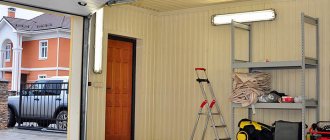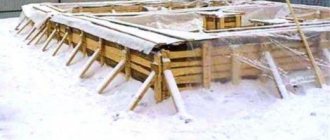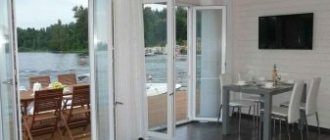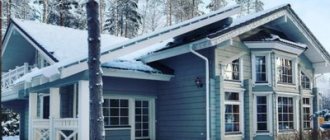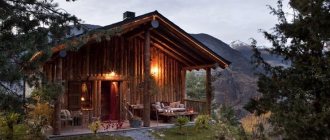Home |Construction |Is it possible to build a house in winter?
Date: November 14, 2017
Comments: 0
Construction of a private house is a complex process, the duration of which depends on many factors. It is not always possible to finish construction that begins in the spring before the onset of cold weather. Many developers are interested in whether it is possible to build a house in winter. They do not want to prolong the completion of work and at the same time they are afraid of making a mistake. Thanks to modern technologies, it is possible to build buildings all year round.
Construction in winter - general specifics of work
Crystallization of water entering concrete is a major problem during winter construction. Without the use of modern methods of heating concrete and the use of modifiers, increased moisture in volume can damage the integrity of the concrete mass.
Regardless of whether brick blocks are used to build a house or concrete is used, the following conditions must be met:
- adhere to technological recommendations for performing work in cold weather;
- provide a thermally insulated room for construction personnel;
- provide a level of illumination that allows you to work after dark.
Despite the seasonal nature of construction work, winter is not an insurmountable obstacle to its implementation
The general algorithm for constructing a building in cold weather, regardless of the materials used, includes the following stages:
- obtaining permits. The issuance of a construction certificate is in no way related to the time of year. You just need to develop the project in a timely manner and submit the necessary documents for registration;
- acquisition and delivery of necessary materials to the site. Costs will be significantly lower due to seasonal discounts. Transporting materials in winter can be much easier, since muddy roads will not interfere with vehicle access;
- carrying out excavation work related to the arrangement of the foundation. Negative temperatures make working on loose soils easier. The use of concrete with additives allows you to pour the foundation at temperatures down to -20 ⁰С;
- construction of main walls and roof construction. When constructing load-bearing walls and partitions, a heated solution or concrete composition with the addition of plasticizers is used. In wooden beams used in frosty weather to build a roof, the moisture concentration is reduced as much as possible;
- implementation of roofing activities and finishing. Not all roofing and finishing materials allow their use at subzero temperatures. To carry out work in winter, you should choose the right materials.
Modern methods can be used to use concrete at low temperatures:
- introduce additives into the concrete mixture that increase the frost resistance of the composition. This will allow construction activities to be carried out at low temperatures;
- heat the concrete during its preparation stage. After pouring, the solution must be insulated so that it hardens completely before the water freezes;
The main part of the problems associated with winter construction is caused by the property of water to freeze at temperatures below zero degrees.
- perform electrode heating by passing current through steel electrodes. The supply voltage is supplied from a step-down transformer;
- use sources of infrared radiation. They allow you to perform directed heating of the mass, as well as increase the temperature of the concrete through the formwork;
- use a heating cable. It is laid in loops with an equal interval between turns before concreting begins, and heats up the concrete solution when voltage is applied;
- install heating formwork. It consists of standard sections that are equipped with electric heaters and are easily combined into a single structure.
Using these methods, it is possible to ensure the required conditions of the concrete solution.
Construction of the foundation in winter
Any permanent house must stand on a foundation; the durability of all building structures depends on its reliability and quality. Therefore, try to ensure the construction of the foundation is as strong as possible, regardless of the weather conditions under which it is carried out.
To do this, you need to delve a little deeper into the properties and composition of cement, which is a binder for concrete and mortar.
Cement sets only at temperatures above zero, so the main task at a construction site in winter is to prevent concrete from freezing.
There are several ways to do this:
- chemical additives that reduce the freezing point of water;
- heating the concrete and mortar immediately before laying;
- insulation of the foundation itself.
The last point is mandatory, regardless of which option you choose.
Here it should be said that chemical additives very often deteriorate the structure of the poured concrete mixture, albeit slightly, but in general this can affect the overall strength of the foundation.
The most effective, although also the most expensive, option is to heat the mixture after pouring with electrodes inserted into the body of the foundation and supplying current to them. There is also another option - you can connect the ends of the metal fittings to the electrical network, which, under the influence of current, will also heat up inside the body of the foundation, and prevent its temperature from falling below a critical value.
Winter construction - pros and cons
Carrying out concrete measures in winter, you can appreciate the following advantages:
- preservation of the landscape of the site. At low temperatures, it will not be damaged by moving construction equipment over frozen soil;
- ease of delivery of building materials. Durable and dry road surface and the absence of mud make it possible to expedite transportation;
- significant savings. The cost of building materials in winter is significantly lower than at other times;
- reduction of work duration. Building the box in winter will allow you to quickly begin finishing with the onset of spring.
The construction of residential buildings has a number of specific requirements that prohibit certain types of construction work in winter
Along with the advantages, there are weaknesses:
- additional costs associated with the use of plasticizers and increased energy consumption;
- the need to use professional equipment for warming up and attract specialists;
- shortened daylight hours and unfavorable weather conditions, negatively affecting the pace of work.
Using specific examples, we will consider the possibility of using various materials at low temperatures.
Disadvantages of bricklaying using the freezing method
- Unpredictability of weather conditions makes it difficult to plan for completion of construction . The work process will have to be interrupted when the temperature drops below -10°C, thaw, snowfall, or blizzard. Only a mild winter is suitable for construction, without critical increases and decreases in air temperature, which in no way relates to concern for the health of the mason.
- People laying eggs in winter must be hardened and resistant to colds. Otherwise, winter construction will be more expensive in terms of the cost of medicines and longer for the period of time required for treatment.
- Saving mortar is the downside of the winter construction process, which is associated with the rapid freezing of the mortar , which does not have additional chemical additives. The mortar is laid out on the previous row of bricks so that the mortar not only does not protrude outward, but also does not reach the edge of the brick. This way it will not spoil the appearance of the outer part of the masonry. A portion of the mortar is laid between the bricks after they are laid at the same distance from each other as the rest. This means that the master must have a perfectly accurate eye.
- The uniform distribution of the mortar between the rows and in the row contributes to uniformity in the design of the masonry . Only the compaction and formation of seams will have to be carried out extremely quickly. If in summer each joint can be formed within 20 or even 30 minutes, then in winter 3-5 minutes are allotted for this stage. When laying the wall of a building, you will have to decorate the outer part of the masonry, interrupting the main process.
- The lower the air temperature outside, the shorter the freezing period of the solution . All this can affect the design of the seams between adjacent masonry elements. In this case, you need to rely on the degree of heating of the air with a hair dryer. By directing a stream of air at the frozen seam, it will be possible to warm the solution and form beautiful recesses, remove excess, as long as in the process you do not direct a stream of hot air (on average 550°C) onto your hands.
- Using a hairdryer, you can remove dried stains of cement mortar from the wall even two days after applying the stains, because by this moment the cement has set, but has not yet hardened. Unfortunately, it is impossible to keep the masonry clean, regardless of whether the object is connected to the electrical network, as in the summer. This is one of the main reasons why masons refuse to build in winter.
- It is necessary to stop work during thaws and winter rain Excess moisture in the cementitious mortar, entering the diluted mixture in the form of rain or directly from wet bricks, will reduce the service life of the connecting element and walls, respectively - under the influence of winds and moisture, after a few seasons, sand will begin to wash out from the hardened concrete, which can lead to destruction of the building.
- It is generally impossible to start construction in winter by laying the foundation in regions where soil freezing . In the central region of Russia, a strip foundation, which is most optimal for building a brick house, can only be poured from mid-April to mid-October. Bored and screw piles provide a greater spread in time, but more effort will be required to drill through frozen soil. Accordingly, the fuel consumption of construction equipment will also increase. If there is an urgent need, you can build a brick wall not only in warm cloudy weather, but also in moderate cold conditions. But it is better to carry out work in dry spring or autumn.
Is it possible to build a house from foam blocks in winter?
Foam blocks are a type of porous concrete. They are characterized by increased performance characteristics: heat-saving properties, high sound insulation, and do not shrink. However, foam blocks have increased water absorption, to prevent which it is necessary to protect the surface.
In winter, you can lay foam blocks. It is important to consider the following points:
- use a solution or glue with frost-resistant characteristics;
- erect a tent-type frame-film structure over the masonry;
- protect the surface of the blocks from moisture using external cladding.
These measures increase the construction budget.
Masonry blocks should not be damp or covered with snow
Is it possible to lay bricks in winter?
The properties of cement mortar affect the strength characteristics of brickwork, as well as for buildings made of foam blocks.
You can use brick for the construction of buildings in winter, observing the following requirements:
- Modifiers should be introduced to reduce the freezing threshold;
- it is necessary to thoroughly clean the brick from snow and ice;
- It is undesirable to use heating the mixture with boiling water, as the cement loses its properties.
Compliance with these recommendations will ensure the strength of brick buildings.
Practical advice
For those who don’t know at what temperature it is possible to lay brickwork outside, experts still advise using summer time as much as possible. The fact is that construction in winter reduces the quality of the masonry, and financial costs increase by about thirty percent.
Before laying bricks in the cold with the addition of anti-frost additives to the masonry mixture, purchase cement material M 300 for preparing the mortar. It will improve the technical parameters of hardening.
If the construction of premises is underway, the operation of which is planned in conditions of high humidity, adding PMD to the mortar mass is strictly prohibited, since the sand-cement mixture will lose its strength.
The thickness of the mortar joint can be maintained at no more than twelve millimeters. Otherwise, during the thawing process, the solution will behave unpredictably, violating the integrity of the masonry.
Is it possible to build a brick house in winter? Yes, only the speed of laying brick stones should exceed the operating mode for the summer season.
In the event of a break in work and frosty weather, when resuming masonry, it is necessary to warm up the upper brick rows using a construction hair dryer. To save time on heating, it is recommended to insulate the laid rows after finishing work.
Is it possible to do masonry when the air temperature drops below twenty degrees below zero? Remember that for such temperature conditions it is best to pause the masonry process.
When performing work using the freezing method, you should not skimp on reinforcement. It is recommended to install reinforced concrete elements over window and door openings.
When carrying out masonry work in winter, special attention is paid to controlling the position of rows vertically and horizontally.
Is it possible to build a house from aerated concrete in winter?
Gas-filled blocks are used in the construction industry, however, they have weaknesses:
- hygroscopicity;
- fragility.
To the question “Is it possible to build with aerated concrete in winter,” the manufacturers of this universal building material unanimously give an affirmative answer
It is allowed to construct buildings from aerated blocks in winter, subject to the following recommendations:
- the material needs waterproofing, since the moisture in the gas block mass, when frozen, can damage the integrity of the block;
- when pouring a reinforced belt under the roof, it is necessary to use concrete with modifying additives;
- finishing of gas-block facades is mandatory, since the cellular material is afraid of dampness.
It is difficult to call aerated concrete a good material for construction in winter. However, if this is preferred, use high quality blocks and use a frost-resistant solution.
Difficulties in carrying out excavation work
It happens that circumstances force excavation work to be carried out in winter. If you find yourself in exactly this situation, then consider the following points:
- The soil should be prepared while it is warm outside. This preparation means draining the soil, because it is wet soil that freezes. The desired result can be achieved by installing drainage ditches around the perimeter of the building site. There are other ways.
- The simplest and most effective method is to saturate the soil with salt solutions. By combining with water in the soil, salt increases its heat capacity. Thermal conductivity also decreases, which leads to a decrease in the freezing point. It is necessary to sprinkle the land with salt during the autumn rains so that the water that goes into the ground saturates the ground to the required depth.
Salt prevents water from freezing
. Tip! If the building site is very large, it will take a lot of salt to salt it out. It is much easier to use the following method, especially considering that the material suitable for this can then be used to insulate a house.
- We are talking about insulating the soil, which will prevent it from freezing during frosts. It is produced using extruded polystyrene foam and dense mineral wool. The latter material is afraid of water, losing its thermal insulation properties, so it must be additionally covered with a waterproofing film.
From the author! The disadvantage of this approach is that by the time the construction time comes, all the insulation can be stolen by unscrupulous enterprising citizens. To prevent this from happening, simply hide the material from view by sprinkling some soil on top of it.
- Another popular method is plowing and harrowing. In warm weather, the soil is plowed to its maximum depth, then the top layer is harrowed. This effect saturates it with air, which is an effective insulation. In fact, a fur coat is created that covers the thickness of the earth from freezing. Very effective, and most importantly, cheap.
Soil development in winter is difficult
- The last method will be good for those who are not prepared at all. The soil is artificially heated and then removed layer by layer. For this purpose, special power stations are used. This method is the most expensive and is used very rarely for private construction.
Building a house in winter using ceramic blocks
Ceramic blocks have the following properties:
- increased resistance to negative temperatures with subsequent thawing;
- high thermal insulation characteristics, thanks to which walls made of ceramic blocks do not require insulation.
To ensure the strength of winter masonry it is necessary:
- introduce plasticizers into cement mortar;
- use a special adhesive composition.
Despite the possibility of using frost-resistant mortars for masonry, manufacturers of ceramic blocks do not recommend laying them at low temperatures.
Winter laying of ceramic blocks has its place - and above all, for reasons of saving money and time
Laying walls.
Masonry can be done in any weather conditions, regardless of the time of year. But it is necessary to take into account some features. Let's look at them.
Features of masonry in summer and winter. Clickable.
The marking of the concrete used is of great importance on the quality of the concrete mixture. It is recommended to use concrete marking M500 and higher.
Winter wood construction
The use of wood for work at sub-zero temperatures has many advantages:
- the material contains less moisture, which reduces the likelihood of rotting;
- frost-dried timber has increased strength and does not form cracks;
- wood is easier to process and retains its geometry.
It is important to protect wooden building materials on the construction site from moisture. This will ensure that its properties are preserved when performing work in winter.
Features of roofing work in the winter season
For the construction of roofs and attics in winter, the following are best suited:
- slate;
- ceramic tiles;
- metal tiles.
They have shown themselves to be the most resistant to frost, and will protect the roof much better than bitumen shingles, which in some places can simply fall apart from cracks caused by the freezing of moisture in the “fresh” material.
For convenience of work, you can build a canopy over the frame of the house to protect the roof from precipitation.
How to protect the roof of a house under construction in winter?
The most important rule is not to install roofing materials that require continuous sheathing - when the weather gets warmer, the wet wood of such sheathing will begin to evaporate moisture and “undermine” the bottom layer of roofing material that is attached closely to it.
And, of course, it is important not to forget to clear snow from roof structures in a timely manner.
Is it allowed to build a house from sip panels in winter?
The construction of buildings from sip panels involves the construction of a wooden frame and the attachment of particle boards to it. There are no wet technologies, there is no need to use plaster and cement, and there is no need to build a strong foundation.
When performing work in cold weather, pay attention to the following points:
- the use of polyurethane foam intended for cold conditions;
- moisture content of wood for the frame, which should not exceed 30%.
A special feature of buildings made from sip panels is the absence of shrinkage. This allows finishing activities to be carried out immediately after construction is completed. Winter activities will allow you to complete the work in the spring and move into your new home by summer!
Interior decoration in winter
If before the frost a person managed to put up a box, make a roof and install windows, the next step will be the interior decoration of the house. If there is no heating in the room and the temperature is below 5°C, it is not recommended to carry out the following work:
- Level the walls with plaster, as it is destroyed in frosts.
- Glue wallpaper to the walls and attach suspended ceilings, as they will bubble when there is a change in humidity.
- Cover the walls with plasterboard: they will crack and become deformed.
In winter, in an unheated room, you can:
- lay brick partitions;
- cover the walls with clapboard;
- make subfloors;
- decorate the walls with plastic panels;
- install metal structures (stairs, doors);
- lay linoleum on the floor.
It is better to postpone all other work until spring.

